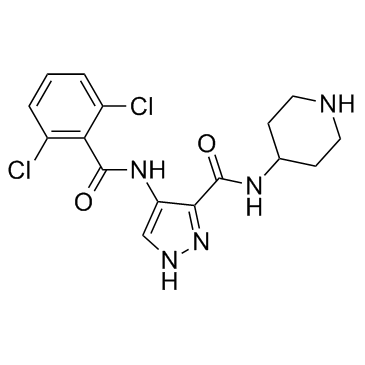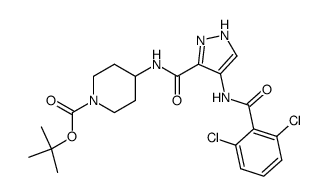844442-38-2
| Name | 4-[(2,6-dichlorobenzoyl)amino]-N-piperidin-4-yl-1H-pyrazole-5-carboxamide |
|---|---|
| Synonyms |
1H-Pyrazole-3-carboxamide, 4-[(2,6-dichlorobenzoyl)amino]-N-4-piperidinyl-
4-[(2,6-Dichlorobenzoyl)amino]-N-(4-piperidinyl)-1H-pyrazole-3-carboxamide UNII-X1BF92PW9T AT 7519 AT7519 cc-301 |
| Description | AT7519 as a potent inhibitor of CDKs, with IC50s of 210, 47, 100, 13, 170, and <10 nM for CDK1, CDK2, CDK4 to CDK6, and CDK9, respectively. |
|---|---|
| Related Catalog | |
| Target |
CDK9/Cyclin T:10 nM (IC50) CDK5/p35:13 nM (IC50) cdk2/cyclin A:47 nM (IC50) Cdk4/cyclin D1:100 nM (IC50) cdk6/cyclin D3:170 nM (IC50) Cdk1/cyclin B:210 nM (IC50) CDK7/Cyclin H/MAT1:2400 nM (IC50) GSK3β:89 nM (IC50) |
| In Vitro | AT7519 (0-4 μM) results in dose-dependent cytotoxicity with IC50s ranging from 0.5 to 2 μM in MM cells, and this induced cytotoxicity is associated with GSK-3β activation independent of transcriptional inhibition. AT7519 overcomes proliferative advantage conferred by cytokines and the protective effect of BMSC. AT7519 (0.5 μM) induces apoptosis of MM cells in a time-dependent manner. Moreover, AT7519 (0.5 μM) inhibits phosphorylation of RNA polymerase II CTD and partially inhibits RNA synthesis in MM.1S cells[1]. AT7519 (250 nM) inhibits cell cycle progression in human tumor cell lines. AT7519 also induces apoptosis of human tumor cell lines[2]. AT7519 (100-700 nM) induces apoptosis in leukemia cell lines. AT7519 also inhibits transcription in human tumor cell lines. Furthermore, AT7519 inhibits RNA polymerase II and reduces antiapoptotic protein levels[3]. |
| In Vivo | AT7519 inhibits tumor growth in a human MM xenograft mouse model[1]. AT7519 (4.6 and 9.1 mg/kg/dose) inhibits the growth of early-stage HCT116 tumor xenografts. AT7519 (10 mg/kg, i.p.) also inhibits the target CDKs in HCT116 tumor-bearing BALB/c nude mice[2]. |
| Cell Assay | AT7519's effects on viability of MM cell lines, primary MM cells, and PBMNCs is assessed by measuring 3-(4,5-dimethylthiazol-2-yl)-2,5 diphenyl tetrasodium bromide (MTT) dye absorbance. DNA synthesis is measured by tritiated thymidine uptake (3H-TdR). MM cells (2-3 × 104 cells/well) are incubated in 96-well culture plates with media and different concentrations of AT7519 and/or recombinant IL-6 (10 ng/mL) or IGF-1 (50 ng/mL) for 24 or 48 h at 37°C and 3H-TdR incorporation is measured. |
| Animal Admin | To evaluate the in vivo anti-MM activity of AT7519, male SCID mice are inoculated subcutaneously with 5×106 MM.1S cells in 100 μL serum-free RPMI 1640 medium. When tumors are measurable, mice are treated intraperitoneally (IP) with vehicle or AT7519 dissolved in saline 0.9%. The first group of 10 mice is treated with 15 mg/kg once a day for five days for 2 weeks, and the second group is treated with 15 mg/kg once a day three times a week for four consecutive weeks. The control group receives the carrier alone at the same schedule. Tumor size is measured every alternate day in 2 dimensions using calipers, and tumor volume is calculated with the formula: V= 0.5 a × b2 (a= long diameter of the tumor, b= short diameter of the tumor). Animals are sacrificed when the tumor reaches 2 cm3 or when the tumor is ulcerated. Survival and tumor growth are evaluated from the first day of treatment until death. |
| References |
| Density | 1.5±0.1 g/cm3 |
|---|---|
| Boiling Point | 586.0±50.0 °C at 760 mmHg |
| Molecular Formula | C16H17Cl2N5O2 |
| Molecular Weight | 382.245 |
| Flash Point | 308.2±30.1 °C |
| Exact Mass | 381.075928 |
| PSA | 102.40000 |
| LogP | 0.95 |
| Vapour Pressure | 0.0±1.6 mmHg at 25°C |
| Index of Refraction | 1.654 |
| Storage condition | -20°C |
|
~% 
844442-38-2 |
| Literature: WO2008/1101 A2, ; Page/Page column 329-330 ; |
| Precursor 1 | |
|---|---|
| DownStream 0 | |
